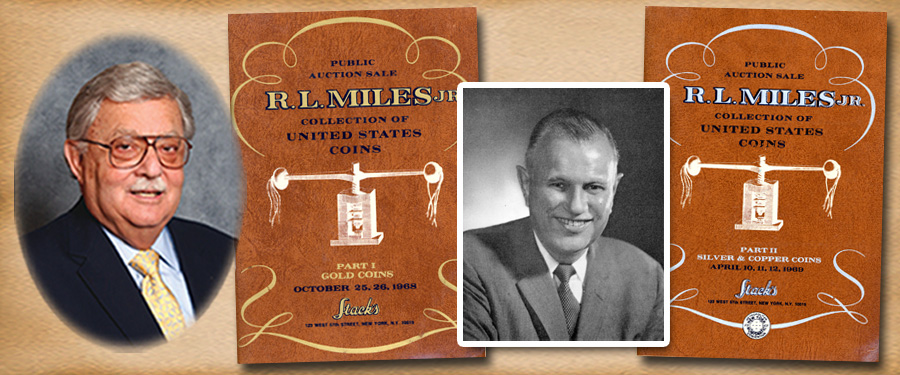
The R.L. Miles, Jr. Collection was formed over four decades, starting with the change found in the coins used in the payroll of the Miles family oyster company. R.L. Miles, Jr. (Skinny as he was known to me) later decided to assemble a high quality collection and went on to create a cabinet of great note. In order to do this, he wanted to set some goals and decided to follow the Guide Book listings for coins from the half cent to the double eagle, and possibly include a set of Panama-Pacific $50 coins.
Skinny acquired varieties as they were listed in the Guide Book, but did not go deeper into specialized varieties. He reviewed many catalogs and bid on many of the coins that Stack’s offered for sale from the late 1940s through the 1960s. Our firm was fortunate to sell many of the great collections that had been assembled by earlier collectors, and this provided great opportunities to those building cabinets during these years.
Skinny also provided Stack’s with a list of items he was seeking to complete a denomination set, and we bid on his behalf at many sales throughout the country. He attended some Stack’s sales; for others he sent in bid sheets and always called before the sales to increase his bids, if necessary, and often gave us leeway to acquire what he wanted. Because he was very active in his business and also an avid bridge player (he had amassed hundreds of major master competitive points during his lifetime), he trusted us to help him finish his collection. As you will see, from the coins we will list in later parts of this story, he accomplished more than many major collectors were able to.
He used the Guide Book as a basic price guide, reviewed auction results to further determine the price of acquiring what he wanted and still remain within his budget. He was lucky in that so many fine collections came to market during this time, that if he missed an item, often during the next year or so another would become available. At that time many coins in Mint State or Proof sold for under $100, some rarities reached the $500 mark, and great rarities went into the multiple thousands. Only a truly great rarity would fetch in the $10,000 to $20,000 range. An 1804 silver dollar sold for a record of $8,000 in the l960s! Silver as a commodity was valued at $1.29 an ounce, so $10 was a good price for a silver dollar. Gold sold for $35 an ounce so $100 was a good price for a scarce $20 gold! There many fewer collectors during that period so prices were not too dear, and it was easier to find many coins.
One of the last coins Skinny acquired was an 1875 $3 gold in Proof. At least one would show up in a sale about once a year. As the going price was, say $7,500, he would bid from $7,750 to $8,250 and always said "no more!" The competition would step up and he would lose it for $500 or so over his bid. The next time he would bid $9,000 to $9,500 and would lose it for $10,250. The next year he would extend his bid to $12,500 and say, “go to $13, 500 if you have to, but no more!" It would realize 14,250. As we came to the end of the 1960s we offered another in a Stack’s sale. Skinny said to me, "I feel certain that all who want one have one. Try to get it for me at $15,000 or a few dollars more. I am tired of trying to finish my $3 series." I felt he was right, and I also did not think that within the next year or so, no others would appear on the market. The lot opened for $12,000, and by $13,500 I felt I had it. However, a new bidder entered at $14,000 so I went up to $15,000. Then someone bid $15,250 and suddenly there was a call out of $16,000. I thought about how he felt and jumped the bid to $16,500. I got it! Now I just had to tell Skinny about what I did.
I called him immediately after the sale. "Did we get it?" I answered, "yes, but I went over your bid!" I told him the price and there was silence on the phone that seemed to last forever, even though it was less than a minute. Then he shouted back to me, "Thank God we got it! I am now finished with my Three’s.” (Of course he knew he could not get a 1870-S as the only example was in the Eliasberg set, and was not for sale),
I had other similar experiences with him and he was always happy with what we did. He appreciated the service we provided him over the many years and we eventually were chosen to sell his collection, after he had accomplished his goals.
More about the man, his coin collection, the relationship we had and the pleasure of dealing with him over the decades.
This story will continue next week with more about R.L. Miles, his coin collection and the relationship we at Stack’s had with him over the decades.





